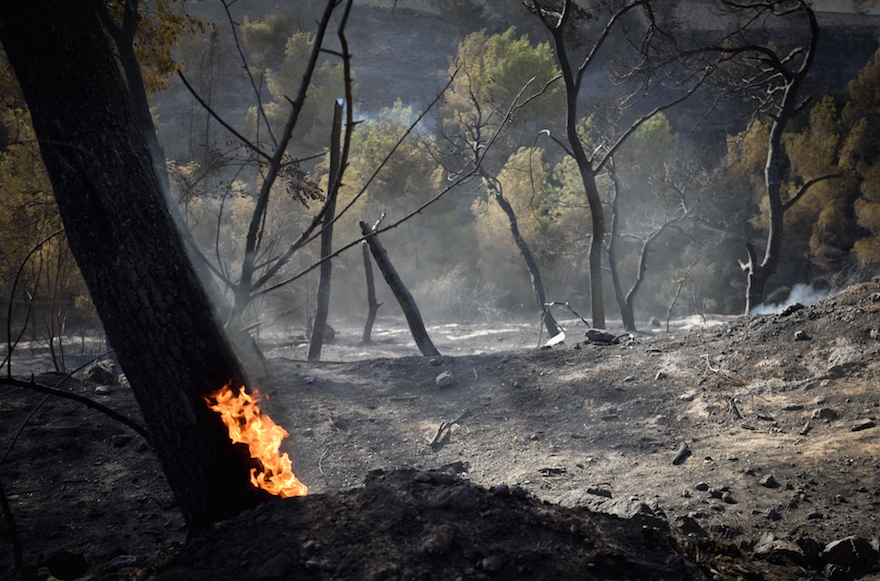Why planting more trees in Israel is a bad idea right now
Published December 5, 2016

Trees aflame in the northern Israeli city of Haifa, Nov. 25, 2016. (Gili Yaari /Flash90)
JERUSALEM (JTA) — Over the past few weeks, more than 1,700 brush fires across Israel have destroyed homes, vehicles and countless irreplaceable personal possessions. As a nation, we have also suffered severe damage to more than 32,000 acres of precious natural resources – woodlands, grasslands and protected parklands, as well as the planted forests and the flora and ground-dwelling fauna that once thrived there.
ADVERTISEMENT
As the smoke clears, organizations and individuals from across the country and around the world are spearheading campaigns to help hundreds of Israeli families reconstruct their homes, restock their shelves and rebuild their lives. At the same time, Prime Minister Benjamin Netanyahu vowed that the people of Israel would replant the forests that were burned.
“In the place of every tree that was blackened, another 10 green trees will bloom,” he declared.
While the sentiment is beautiful, ecology – the “facts in the ground,” if you will – dictates that the impulsive “plant, baby, plant” ideology commonly promoted by the Israeli government and the Jewish National Fund-Keren Kayemeth LeIsrael would only add insult to injury at this critical juncture. Put simply, replanting the forests would do irreversible damage to Israel’s already weakened ecosystem.
Having swapped countless trees for thousands of acres of scorched earth, the affected areas are in a very fragile ecological state. Disrupting it further by initiating tree-planting campaigns would be counterproductive at best. The reason, as explained to me in detail by our top ecologists at the Society for the Protection of Nature in Israel, is twofold.

Jay Shofet (SPNI)
First, the destructive nature of the tree-planting process itself could do untold damage to the fragile soil. While most people who “donate trees” to Israel maintain the romanticized notion that small teams plant the trees by hand, the reality is that the process has “evolved” to become an industrial-style undertaking. Because so many of the trees and other plants that had been protecting the soil are now gone, the threats of severe soil erosion and runoff due to wind and rain are very serious. Tree-planting staff and vehicles entering the sensitive areas would erode the soil further, leading to unnecessary long-term damage.
Second, forests are capable of rejuvenating naturally, so planting additional trees would be redundant and harmful, with seedlings and saplings competing for nutrients and room to grow. As such, the rehabilitation process must rely on the natural renewal capabilities of the affected region based on the natural seed bank found in the ground itself, not on initiated tree planting.
ADVERTISEMENT
Knowing all this, you can understand why ecologists from the Society for the Protection of Nature in Israel are urging the public to allow nature to run its course. It’s clear to us that the only way forward is patience, careful planning and consultation with experts in the field.
Make no mistake: Being patient doesn’t mean sitting idle. We need to simultaneously launch a full-scale ecological survey to see how the affected areas are reacting naturally, and begin the development of “buffer zones” between human living areas and the previously wooded areas.
In the aftermath of forest fires, highly adaptive and “opportunistic” plants like pine trees begin to overwhelm the affected areas. Our biggest challenge is effectively diluting these young seedlings so they won’t develop and create a dense carpet of green cover. If we mobilize teams quickly, we can prevent this and create a less dense and more patchy and diverse vegetation cover. If we allow the pine trees to grow – or support campaigns to plant even more pine trees in the devastated areas – we will do great damage to the natural balance and set the stage for yet another wildfire, due to the species’ repeatedly proven high flammability.
The final stage of the healing process is education. In addition to promoting the information stated above, we must also make the Israeli public understand that the slow and natural regrowth of our Mediterranean shrubland and grassland is not a failure – it is what’s best for the land that we love. Though many well-intentioned Zionists might prefer the image of trees standing tall in a majestic Israeli forest, the truth is that the shrubland ecosystem is a high-value area for biodiversity and must be protected. In addition, Israel sorely needs more open spaces to mitigate its cycle of wildfires.
We can no longer afford to act first and ask questions later. We cannot blindly do whatever feels right without consulting the experts. We must find options that will enrich our biodiversity.
As winter sets in, it may be difficult to see that patience and planning is, in fact, the way forward. But when all the affected areas are green and lush this spring, we will all be happy that we stood our ground.
(Jay Shofet is the director of partnerships and development at the Society for the Protection of Nature in Israel, the oldest and largest environmental nonprofit organization in Israel. He previously served as the executive director of the Jerusalem-based Green Environment Fund.)













